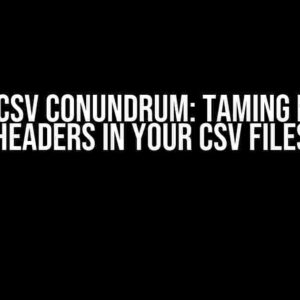Table cells, those pesky little boxes that hold our precious data, can be notoriously finicky when it comes to text wrapping. Specifically, when the final cell in a table row has a width of 100%, achieving consistent text wrapping can become a frustrating challenge. Fear not, dear developer, for today we’re going to tackle this issue head-on and emerge victorious!
Why Does This Happen?
Before we dive into the solution, let’s understand the root of the problem. When a table cell has a width of 100%, it means it takes up the entire available width of the table. Sounds reasonable, right? The issue arises when the text within that cell doesn’t wrap correctly, causing it to spill over into adjacent cells or (worse still) get clipped off altogether.
CSS to the Rescue!
Enter our trusty sidekick, CSS! To enforce consistent text wrapping in table cells with a width of 100%, we’ll employ a few clever CSS tricks. But before we do, let’s set the stage with a basic table structure:
<table>
<tr>
<td>Cell 1</td>
<td>Cell 2</td>
<td style="width: 100%;">Cell 3 (Width 100%)</td>
</tr>
</table>
Now, let’s add some CSS magic to make our table cells behave:
table {
table-layout: fixed; /* Essential for consistent text wrapping */
width: 100%; /* Make the table take up the full available width */
}
td {
overflow-wrap: break-word; /* Allow words to break and wrap */
word-break: break-all; /* Break words at any character */
}
td:last-child { /* Target the last cell in each row */
width: 100%; /* Ensure it takes up the full available width */
white-space: nowrap; /* Prevent inline elements from wrapping */
padding: 10px; /* Add some breathing room */
box-sizing: border-box; /* Include padding in the width calculation */
}
The Explanation
Let’s break down what’s happening here:
table-layout: fixed;ensures that the table cells take up equal widths, making it easier to control text wrapping.overflow-wrap: break-word;andword-break: break-all;allow words to break and wrap within the table cells.td:last-childtargets the last cell in each row, which has a width of 100%.white-space: nowrap;prevents inline elements (like spans or links) from wrapping, keeping them on a single line.padding: 10px;adds some space between the cell content and the borders, making the text more readable.box-sizing: border-box;includes the padding in the width calculation, ensuring that the cell takes up the full available width.
Real-World Scenarios
Now that we’ve conquered the basic table structure, let’s explore some common scenarios where this CSS comes into play:
Scenario 1: Text-Heavy Cells
Sometimes, our table cells contain large amounts of text. In these cases, we want to ensure that the text wraps correctly and doesn’t overflow:
<table>
<tr>
<td>Cell 1</td>
<td>Cell 2</td>
<td style="width: 100%;">This cell contains a lot of text, but thanks to our CSS, it will wrap correctly and not overflow.</td>
</tr>
</table>
Scenario 2: Mixed Content Cells
What if our table cells contain a mix of text and inline elements, like images or links?
<table>
<tr>
<td>Cell 1</td>
<td>Cell 2</td>
<td style="width: 100%;">This cell has an image <img src="image.jpg" alt="Image"> and some text, but it will still wrap correctly thanks to our CSS.</td>
</tr>
</table>
Scenario 3: Responsive Tables
In responsive design, tables often need to adapt to different screen sizes. Our CSS ensures that the table cells wrap correctly, even when the table is resized:
<table>
<tr>
<td>Cell 1</td>
<td>Cell 2</td>
<td style="width: 100%;">This cell will wrap correctly, even when the table is resized to fit smaller screens.</td>
</tr>
</table>
Browser Compatibility
As with any CSS solution, it’s essential to ensure that our code works across various browsers and versions. Fortunately, the CSS properties used in this solution are well-supported:
table-layout: fixed;: Supported in IE10+, Firefox, Chrome, Safari, and Opera.overflow-wrap: break-word;andword-break: break-all;: Supported in IE10+, Firefox, Chrome, Safari, and Opera.white-space: nowrap;: Supported in IE6+, Firefox, Chrome, Safari, and Opera.box-sizing: border-box;: Supported in IE8+, Firefox, Chrome, Safari, and Opera.
Conclusion
By employing these clever CSS tricks, you can finally tame the unruly table cell and achieve consistent text wrapping when the final cell has a width of 100%. Remember to test your solution across various browsers and scenarios to ensure it works as expected.
With this solution, you’ll be well on your way to creating beautiful, responsive tables that adapt to any situation. Happy coding!
Additional Resources
If you’re interested in learning more about table styling and layout, check out these resources:
Here are 5 Questions and Answers about “Enforcing consistent table-cell text wrapping when final cell is "width 100%"”:
Frequently Asked Question
Get the answers to your most pressing questions about enforcing consistent table-cell text wrapping when the final cell is set to “width 100%”.
Why do table cells not wrap text consistently when the final cell has a width of 100%?
This is because when the final cell has a width of 100%, it takes up the remaining width of the table, causing the text to not wrap consistently. This is due to the default behavior of HTML tables, where the last cell expands to fill the available space.
How can I enforce consistent text wrapping in table cells when the final cell is set to “width 100%”?
You can use the `table-layout: fixed` attribute on the table element, which forces the table to distribute the width evenly across all cells, including the final cell with a width of 100%. This ensures consistent text wrapping across all cells.
Will using `table-layout: fixed` affect the overall layout of my table?
Yes, using `table-layout: fixed` can affect the overall layout of your table, as it forces the table to distribute the width evenly across all cells. This means that if you have cells with varying widths, the table may not look as intended. You may need to adjust your table layout and cell widths accordingly.
Are there any alternative solutions to `table-layout: fixed` for enforcing consistent text wrapping?
Yes, you can use CSS styles such as `word-break: break-word` or `overflow-wrap: break-word` on the table cells to enforce consistent text wrapping. Alternatively, you can use JavaScript to dynamically adjust the widths of the table cells to ensure consistent text wrapping.
Can I use CSS grid or flexbox instead of HTML tables to achieve consistent text wrapping?
Yes, you can use CSS grid or flexbox to create a layout that resembles a table, and achieve consistent text wrapping. These modern layout modes offer more flexibility and control over layout and text wrapping, making them a popular alternative to traditional HTML tables.





